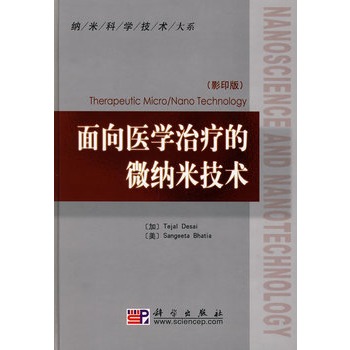|
|
|
 |
| 《面向医学治疗的微纳米技术(影印)》 |
| 作者:(加)德塞(Desai,T.)(美)马蒂亚(Bhatia,S.) 编著,Therapeutic Micro/Nano Technology.-影印本 |
| 出版社:科学出版社 |
出版日期:2008/5/1 |
| ISBN:9787030223395 |
定价: 88.00元 |
|
内容推荐
本书讨论了正在兴起的治疗性微米和纳米技术领域。本书所覆盖的主题包括:基于细胞的治疗技术,再生医学——细胞与微米和纳米系统整合(融合),MEMS与细胞和组织的集成;药物的传递-用于血管内物靶向传递的纳米粒子和非血管系统的药物传递系统(植入性的、口服的、吸入性的);用于生物界面的分子表面工程,生物分子图案化和细胞图案化。
本书可供从事纳米科技、材料科学、生物化学和医学的科研人员,高等院校研究生、教学人员参考。
目录
List of Contributors
Foreword
Preface
I.Cell-based Therapeutics
1.Nano-and Micro-Technology to Spatially and Temporally Control
Proteins for Neural Regeneration
Anjana Jain and Ravi V Bellamkonda
1.1 Introduction
1.1.1 Response after Injury in CNS and PNS
1.1.2 Nano-and Micro-scale Strategies to Promote Axonal Outgrowth in the CNS and PNS
1.2 Spatially Controlling Proteins
1.2.1 Spatial Control: Permissive Bioactive Hydrogel Scaffolds for Enhanced Regeneration
1.2.2 Spatial Control: Chemical vs.Photochemical Crosslinkers for Immobilization of Bioactive Agents
1.2.3 Other Hydrogel Scaffolds
1.2.4 Spatial Control: Contact.Guidance as a Strategy to Promote Regeneration
1.2.5 Spatial Control: Nerve Guide Conduits Provide an Environment for Axonal Regeneration
1.2.6 Spatial Control: Cell-scaffold Constructs as a Way of Combining Permissive Substrates with Stimuli for Regeneration
1.3 Temporally Controlling the Release of Proteins
1.3.1 Temporal Control: Osmotic Pumps Release Protein to Encourage Axonal Outgrowth
1.3.2 Temporal Control: Slow Release of Trophic Factors Using Microspheres
1.3.3 Temporal Control: Lipid Microtubules for Sustained Release of Stimulatory Trophic Factors
1.3.4 Temporal Control: Demand Driven Release of Trophic Factors
1.4 Conclusion
References
2.3-D Fabrication Technology for Tissue Engineering
Alice A.Chen, Valerie Liu Tsang, Dirk Albrecht, and Sangeeta N.Bhatia
2.1 Introduction
2.2 Fabrication of Acellular Constructs
2.2.1 Heat-Mediated 3D Fabrication
2.2.2 Light-Mediated Fabrication
2.2.3 Adhesive-Mediated Fabrication
2.2.4 Indirect Fabrication by Molding
2.3 Fabrication of Cellular Constructs
2.4 Fabrication of Hybrid Cell/Scaffold Constructs
2.4.1 Cell-laden Hydrogel Scaffolds by Molding
3.3.4 Extensive Neurite Outgrowth and Active Synapse Formation on PuraMatrix
3.3.5 Compatible with Bioproduction and Clinical Application
3.3.6 Synthetic Origin and Clinical-Grade Quality
3.3.7 Tailor-Made PuraMatrix
3.4 Peptide Surfactants/Detergents Stabilize Membrane Proteins
3.5 Perspective and Remarks
Acknowledgements
References
4.At the Interface: Advanced Mierofluidic Assays for Study of Cell Function
Yoko Kamotani, Dongeun Huh, Nobuyuki Futai, and Shuichi Takayama
4.1 Introduction
4.2 Microfabrication
4.2.1 Soft Lithography……
5.Multi-phenotypie Cellular Arrays for Biosensing
6.MEMS and Neurosurgery
II.Drug Delivery
7.Vascular Zip Codes and Nanoparticle Targeting
8.Engineering Biocompatible Quantum Dots for Ultrasensitive,Real-Time Biological Imaging and Detection
9.Diagnostic and Therapeutic Applications of Metal Nanoshells
10.Nanoporous Microsystems for Islet Cell Replacement
11.Medical Nanotechnology and Pulmonary Pathology
12.Nanodesigned Pore-Containing Systems for Biosensing and Controlled Drug Release
13.Trandermal Drug Delivery using Low-Frequency Sonophoresis
14.Microdevices for Oral Drug Delivery
15.Nanoporous Implants for Controlled Drug Delivery
III.Molecular Surface Engineering for the Biological Interface
16.Micro and Nanoscale Smart Polymer Technologies in Biomedicine
17.Supported Lipid Bilayers as Mimics for Cell Surfaces
18.Engineering Cell Adhesion
19.Cell Biology on a Chip
About the Editors
Index
|
|
|